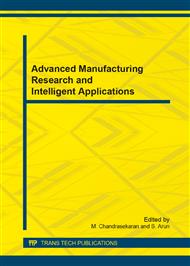p.3
p.7
p.11
p.15
p.19
p.23
p.27
p.33
p.38
Improving the Hardness of a Wind Turbine Gear Surface by Nitriding Process
Abstract:
This paper presents a surface hardness improvement methodology of a wind turbine helical gear which is made up on EN36 alloy steel material. Now days the wind turbine gears are frequently failed due to high contact stress, due to sudden impact load, change of wind speed and wind directions. Pitting is a method of surface failure in a gear. So, to avoid the gear failures we need to improve the surface hardness of wind turbine gears by using Nitriding process. There are three modes of hardness test taken from this process to improve the hardness. They are before nitriding, after nitriding & without nitriding. By comparing the hardness test values, Gas Nitriding is the best suitable process to increase the surface hardness of a large size gear. By the method of improving surface hardness of wind turbine gear, the load withstanding capacity of the wind turbine gears are increased, pitting failure may be avoided at a desired level and the power production rate is increased.
Info:
Periodical:
Pages:
19-22
Citation:
Online since:
July 2014
Authors:
Keywords:
Price:
Сopyright:
© 2014 Trans Tech Publications Ltd. All Rights Reserved
Share:
Citation:


